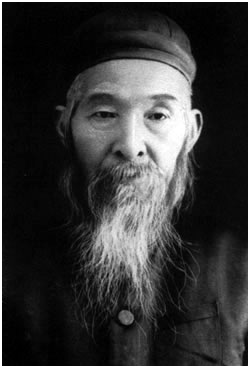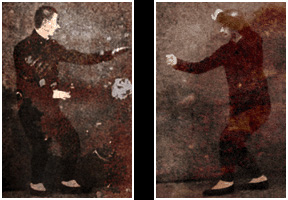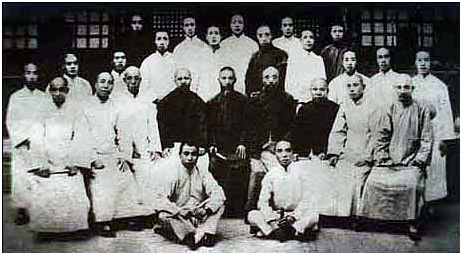Sun style Tai Chi - History:
Sun Lu Tang:
Sun style Tai-chi was created by the famous martial arts master Sun Lu-tang (Serng Luk-tong – Cantonese), in Beijing, during the late 19th century.
Already a master of two major schools of internal martial arts, Hsing-yi and Ba-gwa, Sun studied Hao style Tai-chi under Hao Wei-zhen.

Sun Lu Tang: 1861 - 1933
Early Years:
Sun Lu-tang grew up with martial arts. He was a very frail child, but had a strong mind and was not afraid to work hard. As a youth, Sun initially studied external Shaolin kung fu. In three short years, the dramatic change it made to his previously weak body had Sun hooked on martial arts forever.
During his martial art career, Sun Lu-tang was lucky enough to train with some of the leading martial artists of the day. His natural talent, honest personality and devotion to training meant that Sun was always looked upon favourably by the masters he trained with.
Hsing-yi:
He first began to study Hsing-yi under Li Kui-yuan, a close friend of Sun’s uncle.
After a number of years of dedicated training Li declared he had nothing more to teach Sun and suggested he study with Li’s own Sifu, Guo Yun-shen.
Manacle Boxing:
Guo Yun-shen loved to fight when he was younger and had a reputation within the martial art community for being a first class fighter. Unfortunately, while working as a bounty hunter he accidently took the life of a criminal he was attempting to apprehend. This incident resulted in Guo serving a three year prison sentence.
During his incarceration Gou was manacled the whole time, but this did not stop him training his Hsing-yi further. In fact in the limited space he had, Guo developed what became known as ‘Boon gor Bung Kune‘, or the half step smashing fist – one of the major techniques within the Gou lineage Hsing-yi system.
Sun studied under Guo for eight years before Guo recommended he develop his kung fu further by studying Ba-gwa as a complimentary style to Hsing Yi.

Sun Lu Tang performing Hsing-yi’s splitting fist (pare kune) and pounding fist (pau kune)
Ba-gwa:
Gou Yun-shen introduced Sun Lu-tang to Cheng Ting-hua in Beijing. Coming from the same province, Cheng and Gou were close friends and kung fu brothers.
Cheng Ting-hua, himself a famous master, was a first generation student under the founder of the Ba-gwa system, Dung Hai-chuan – a martial arts legend in his own lifetime.
Footwork:
Although Cheng was impressed with Sun’s previous martial art training, he only allowed him to train the very basics of the Ba-gwa system for the first few years.
Ba-gwa was recommended to Sun to add circular mobile footwork to the linear movement patterns trained in Hsing-yi. Sun therefore spent much of his training time walking the Ba-gwa circle. However, behind his teachers back he also worked on developing power by striking old iron cannons, located in an area behind the Forbidden City.
Challenge:
Sun’s big Ba-gwa break came when a challenger from the south arrived to take on Cheng Ting-hua. As formality dictated the challenger had already beat all of Cheng’s senior students and was finally ready to challenge Cheng directly.
Although only a junior student at the time, Sun requested an opportunity to fight in Cheng’s place, which Cheng reluctantly granted. When the fight began Sun stepped around the challenger with the Ba-gwa footwork and hit the southerner with the power he’d developed from hitting the cannons. The strike was so hard, the challenger was thrown through the window. Cheng was delighted by the result.
Over the next three years Cheng taught Sun the full Ba-gwa empty hand, sword and spear systems. Finally declaring he had nothing left to teach him, Cheng recommended Sun go out on his own as a full inheritor of the Ba-gwa style. From that point on, Sun’s reputation as a first class Hsing-yi and Ba-gwa master grew. Although it was many years before Sun was finally exposed to the intricacies of the third major internal system - Tai-chi.

Sun Lu-tang demonstrating the Ba-gwa double palm change
Tai Chi:
In the summer of 1914, Hao Wei-zhen arrived in the capital, Beijing, but was taken ill and checked himself into a local inn to rest.
Sun knew of Hao’s martial arts reputation and when he heard of this famous master’s illness, he insisted Hao come stay at his home until he recovered. At this point Sun did not know which martial art Hao practised, but he took great care of him during his illness. Eventually Hao recovered sufficiently to move on, but before he left he repaid Sun’s kindness by teaching him the complete Hao family Tai-chi system.
Combination of Three:
After many years of research, Sun eventually took the critical elements of all three internal styles; Hsing-yi, Ba-gwa and Tai-chi, and combined them into a single Tai-chi system.
Sun style Tai-chi has been described as containing Ba-gwa’s stepping method, with Hsing-yi’s leg and waist movements and Tai-chi’s body softness. The cultivation and flow of chi throughout the body was a major concern for Sun when creating his system. The attention he put into energy flow to ensure energy is channeled correctly within the body, is shown in the soft, natural body movements of the Sun style form.

Sun Lu-tang (centre) with a group of Hsing-yi students, Shanxi province, 1924
Scholar Boxer:
Although never trained as a scholar, Sun-Lu-tang educated himself throughout his life in calligraphy, the Chinese literary classics, the Yi-jing (book of changes) and mathematics.
This was not a common practice during that era, as the majority of martial artists at that point were illiterate. The culmination of his martial endeavours and his literary prowess came together towards the end of his life, when he authored five books, combining theories on internal martial arts, Chinese philosophy and Taoist chi cultivation. The books were a huge success in China at the time and are considered classics today.